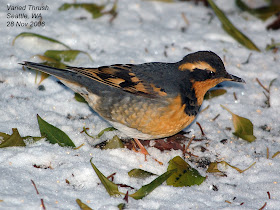Some people, seeing their first Varied Thrush (Ixoreus naevius), wonder if they are
having vision problems. This psychedelically colored thrush looks more or less
like an American Robin (Turdus
migratorius) and feeds on the ground or in fruit trees like a robin, but
the similarity is only superficial.
Male Varied Thrushes are vividly colored in gray, black and russet, much more brightly patterned than robins. Females are more subdued, with less conspicuous facial markings and breast band, but they still show the vivid wing markings typical of the species. Note also their black instead of yellow bill.
While robins run about our yards looking for earthworms that
have surfaced, Varied Thrushes are foraging for a much greater variety of
invertebrates. A robin is a visual forager, cocking its head to scan for worms,
but a Varied Thrush gets down and dirty, pulling leaf litter up and hopping
backward to examine the ground exposed. The complex web of life beneath the
litter furnishes up dietary items one after another to the thrush.
In addition, Varied Thrushes take fruits and seeds of all kinds,
even acorns, from the ground. They often visit bird feeders to take seeds or
suet, something robins never do. Both species are attracted to fruiting trees
and shrubs, where they may gobble berry after berry, jumping up or briefly
hovering to pull them from branches to small for a comfortable perch.
Varied Thrushes breed in wet conifer forests in the
mountains of the Pacific Northwest, and they are present in the lowlands only
in winter, when they come down from the mountains. In some winters, probably
the colder and snowier ones, they are more common than at other times, numerous
enough to be called an invasion. At intervals they wander much more widely than
their usual range in the far West, turning up as far east as the Atlantic
coast.
The call note of a Varied Thrush is a sharp 'tup,' much like
that of a Hermit Thrush, but the song is magical. It is a series of drawn-out
notes at different pitches, sometimes with overtones. Note after note comes out
of the bird with an ethereal quality that seems well suited for our dark evergreen
forests. Fortunately for us, they sing commonly in the spring before they
depart for the mountains, so you may hear this song in your suburban yard.
Watch for the psychedelic robin; it's that time of year!
Dennis Paulson






4.jpg)















